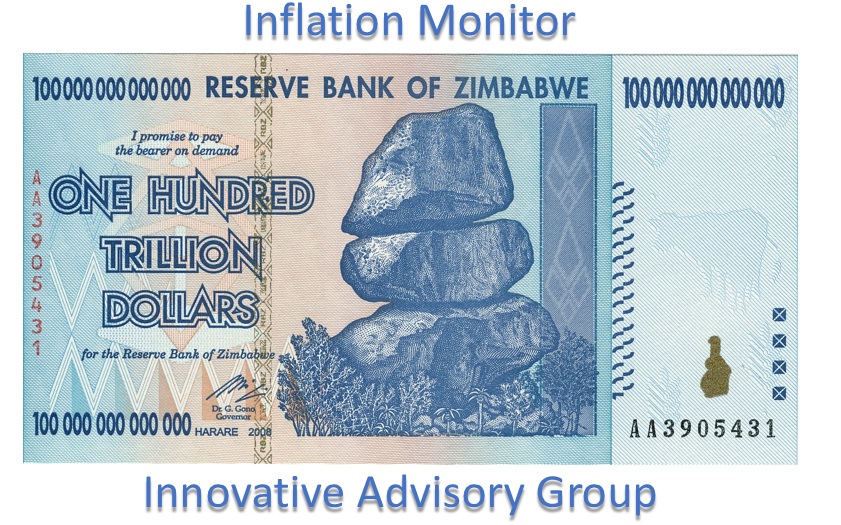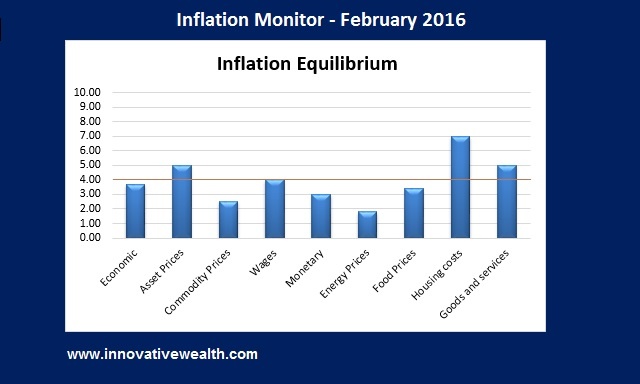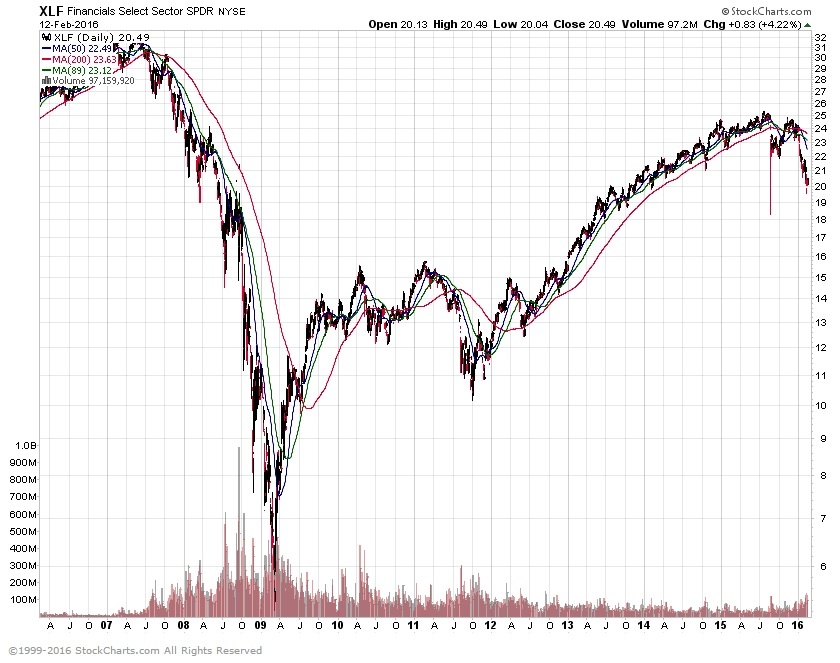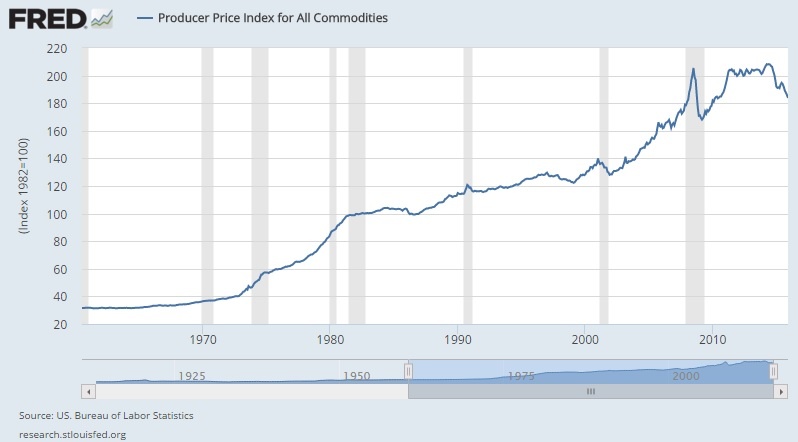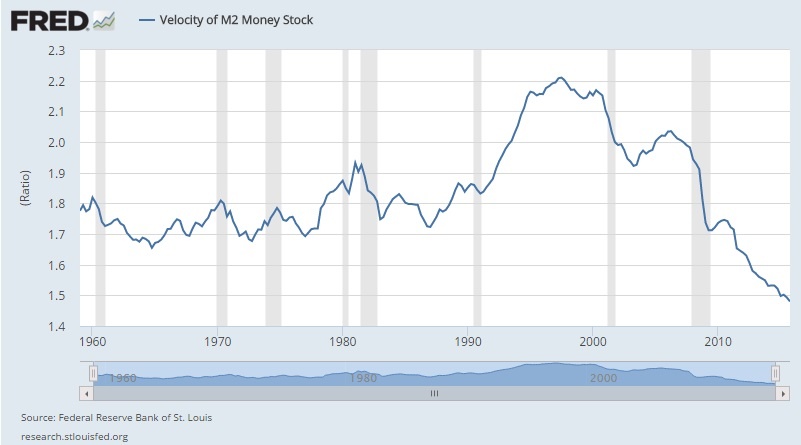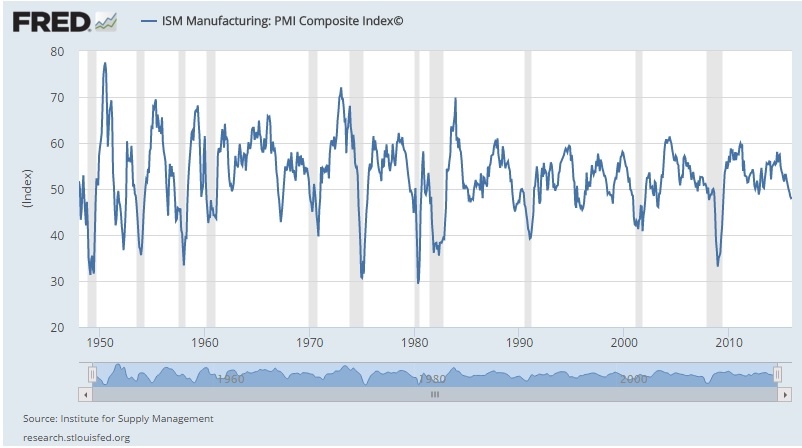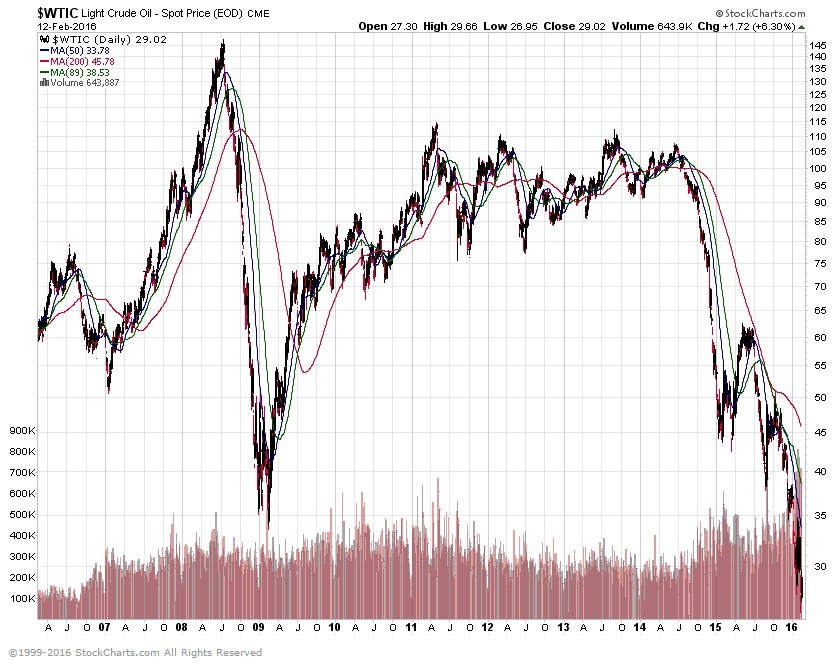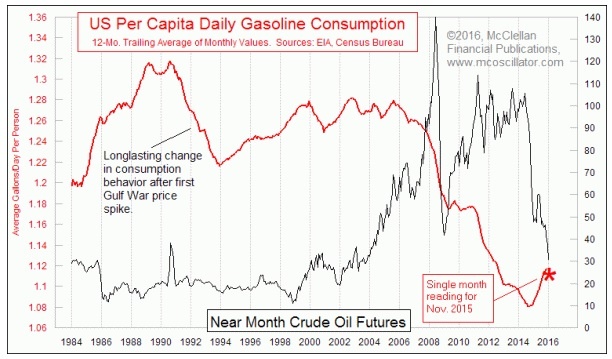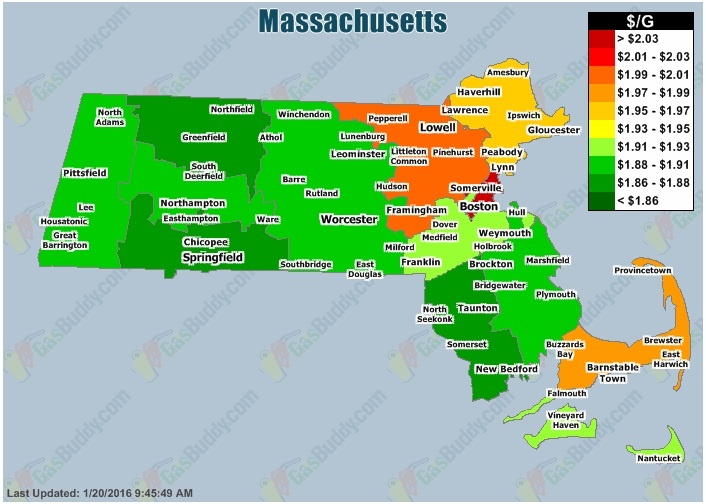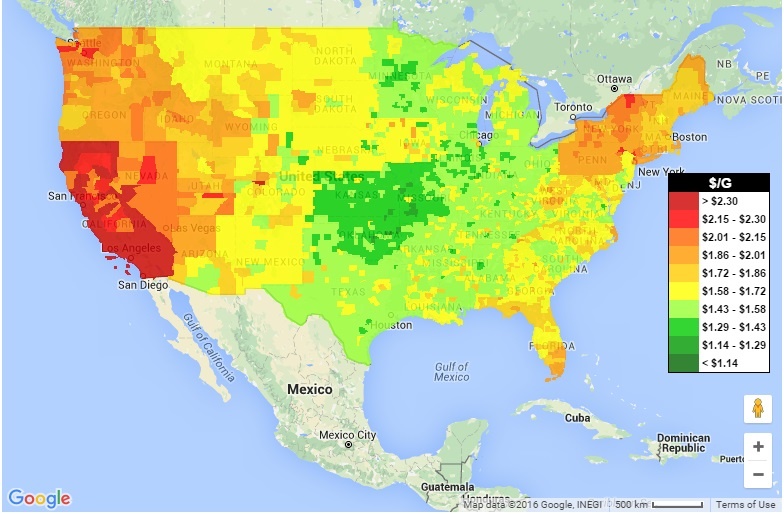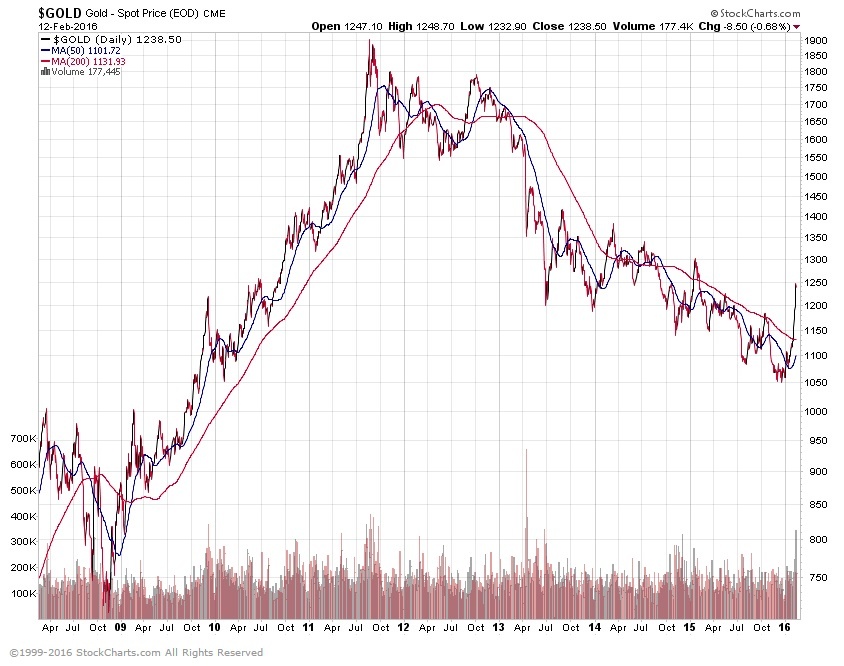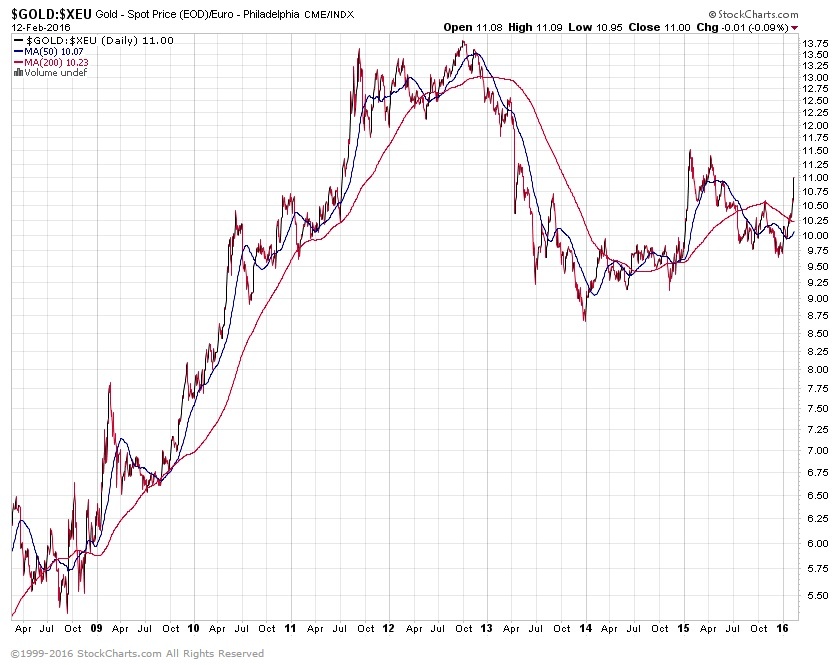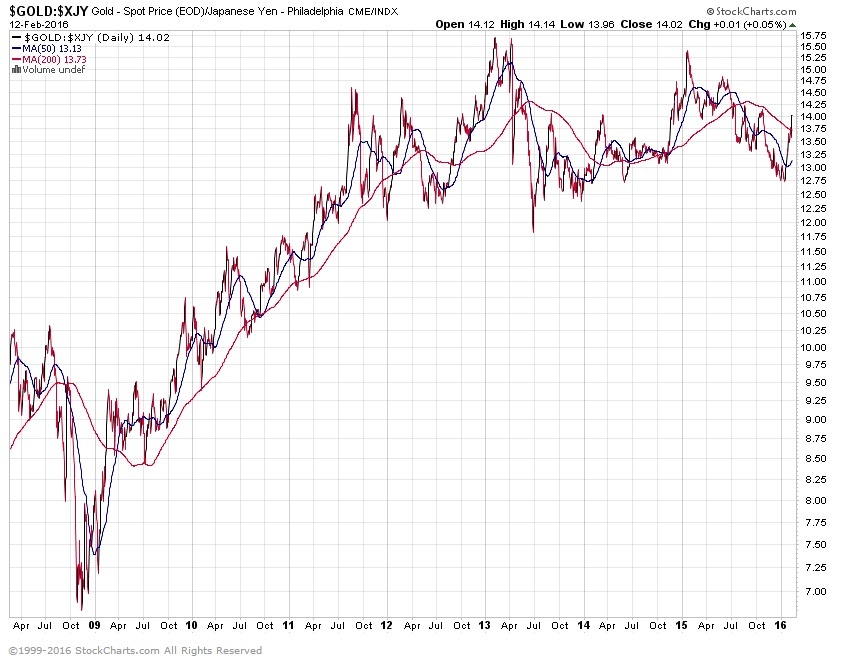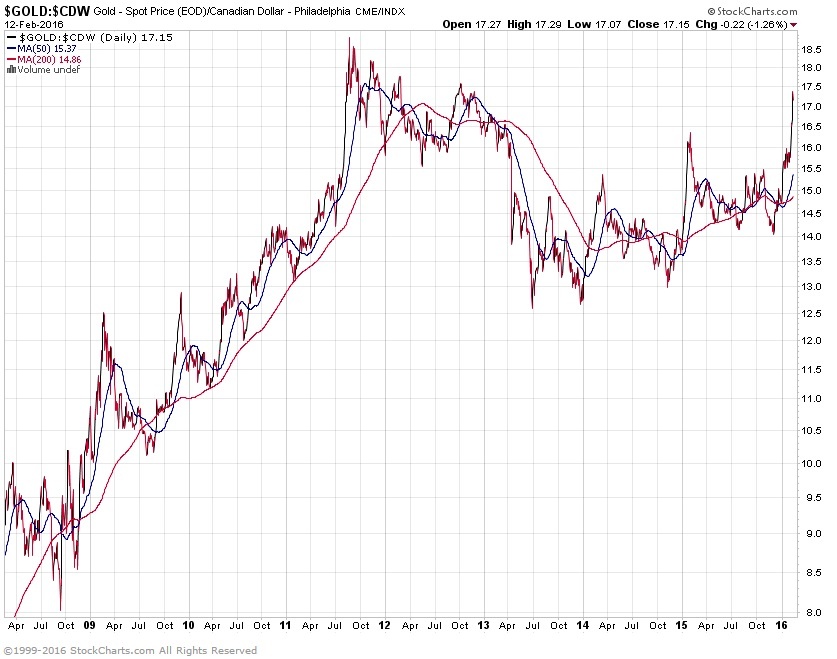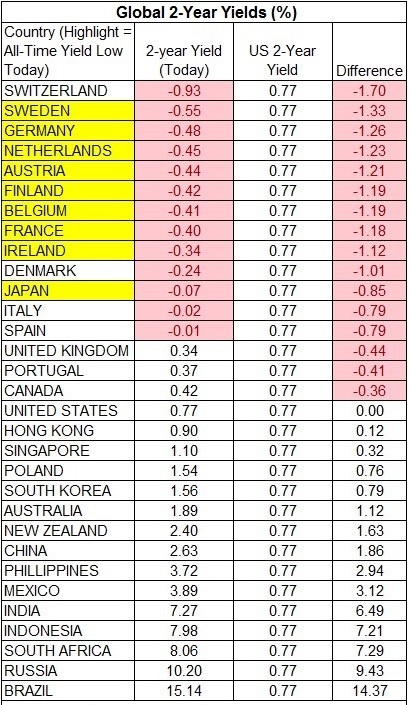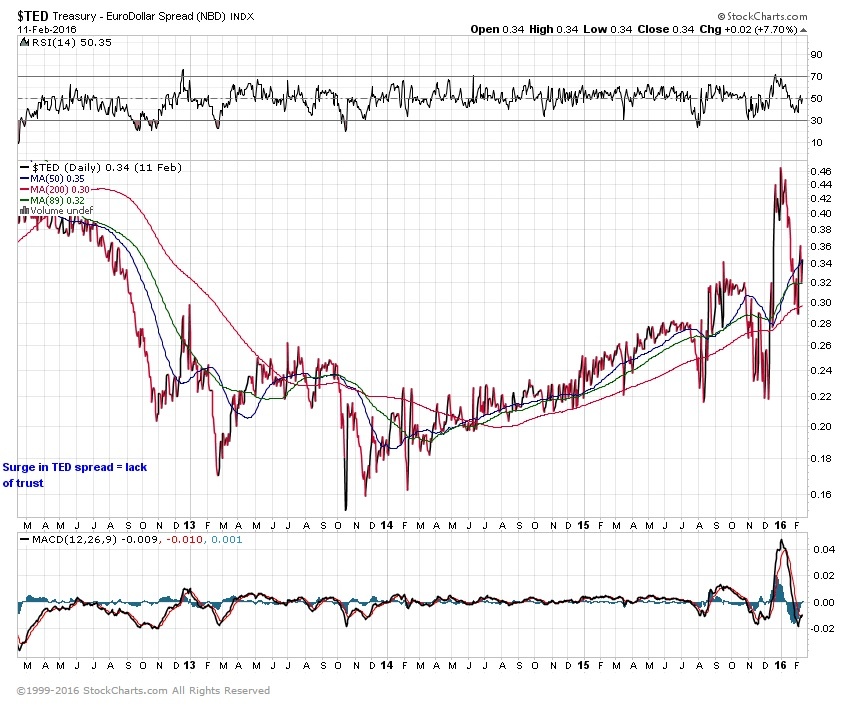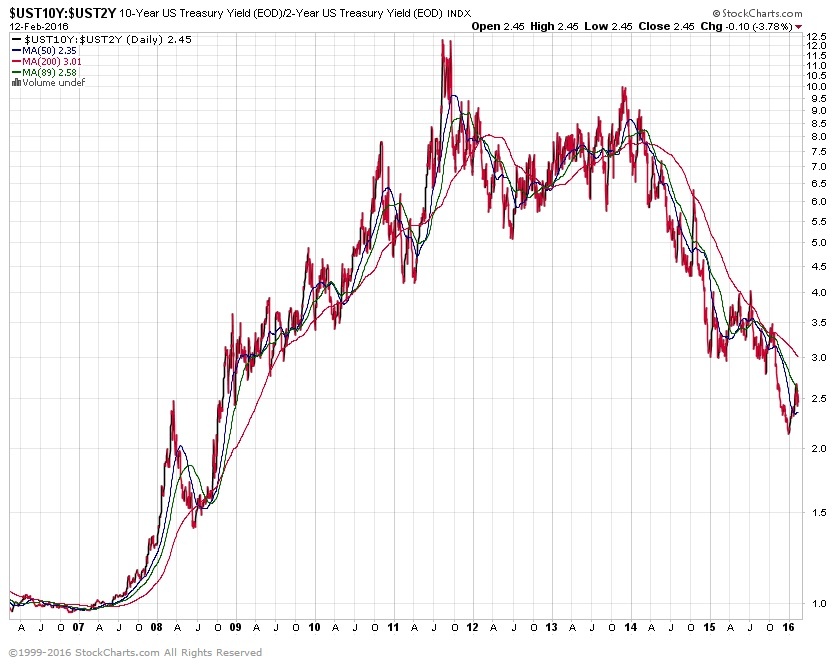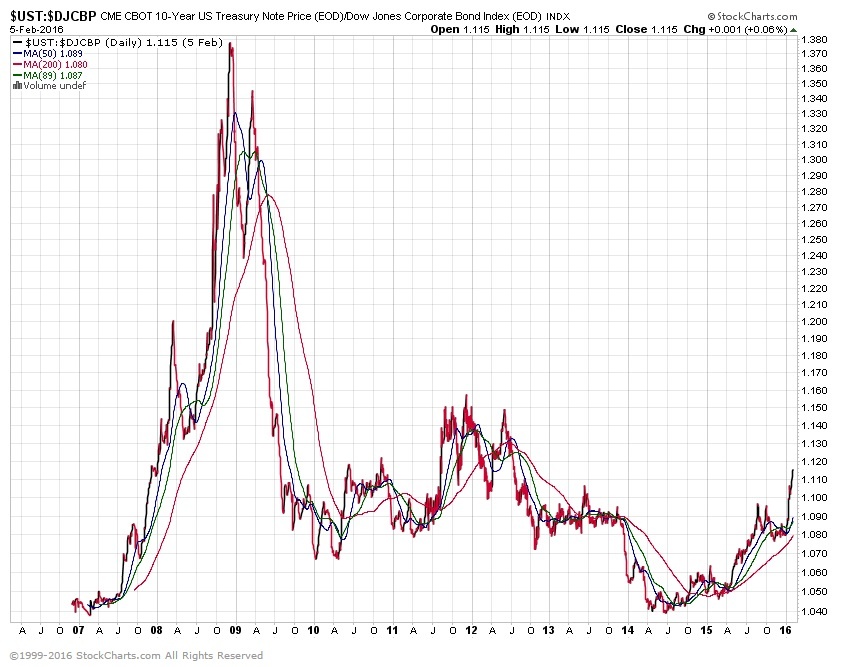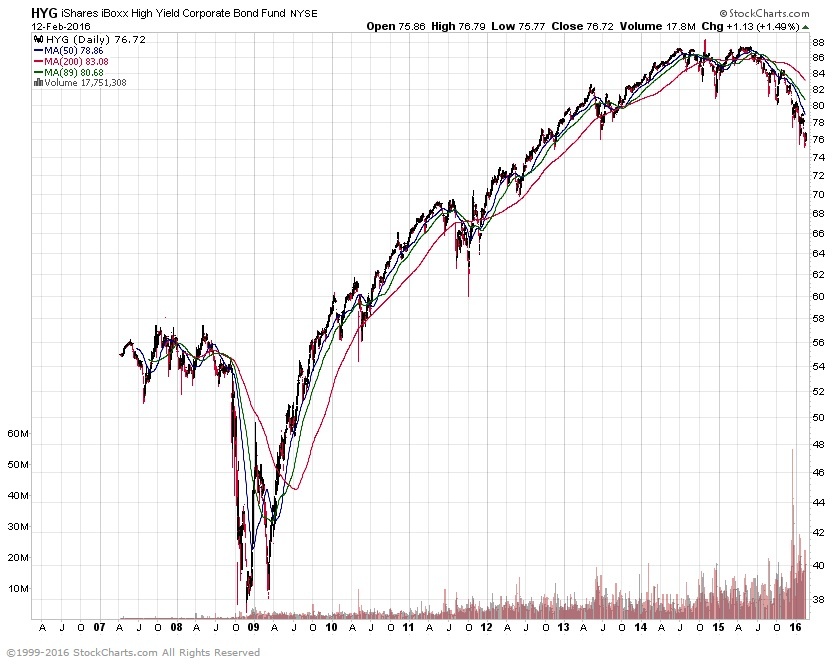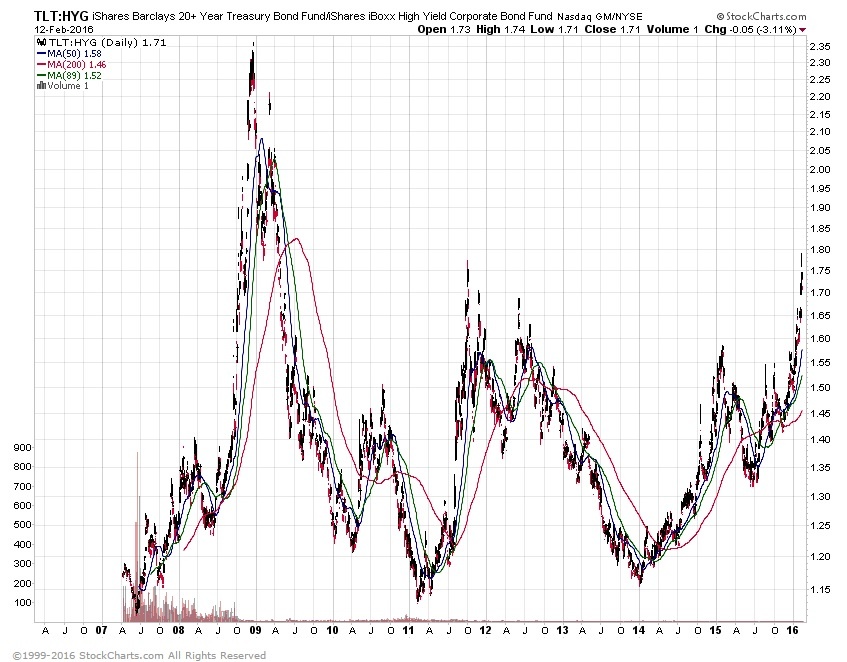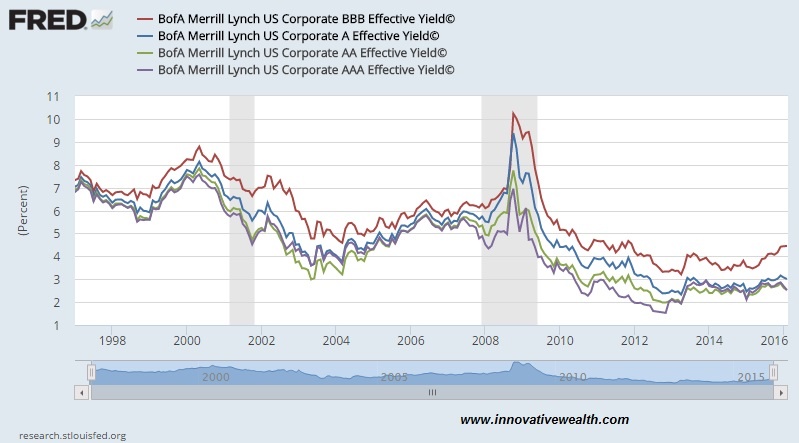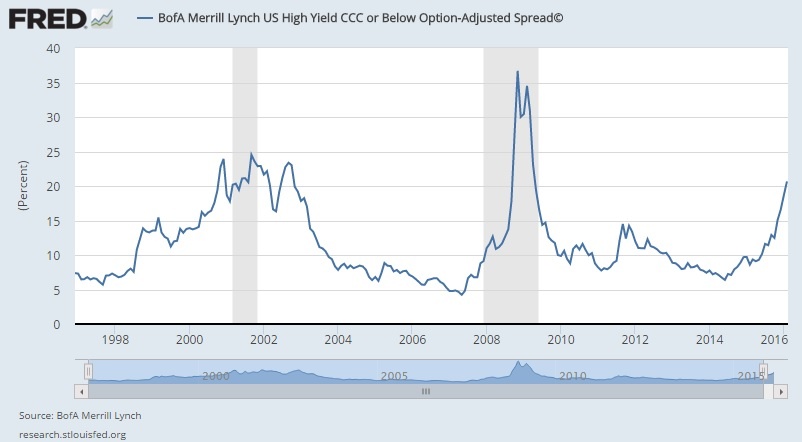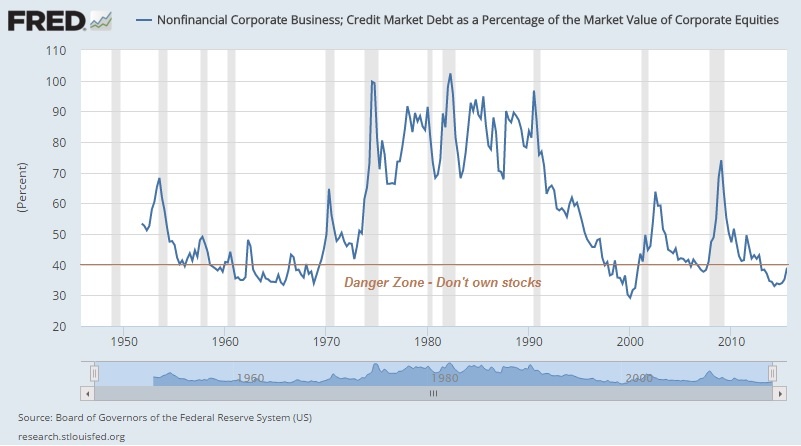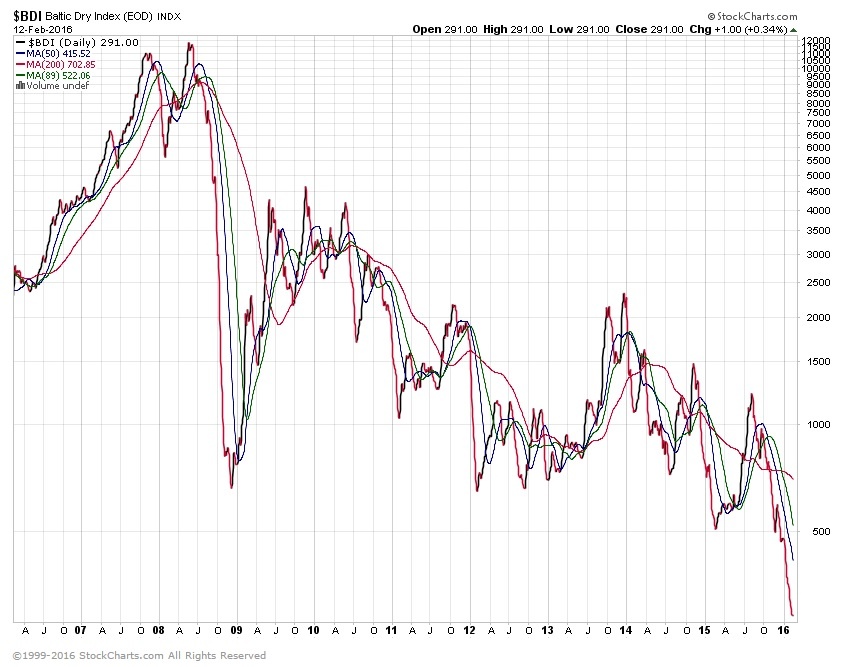| Index | Value | 1mo change | 1yr change | 5yr change | Inflation Score |
|---|---|---|---|---|---|
| Economic Inflation | |||||
| Consumer Price Index (CPI) | 236.92 | 0.17% | 1.37% | 7.58% | 2 |
| Producer Price Index (PPI) | 182.50 | -0.71% | -5.00% | -5.29% | 1 |
| 1 Yr Treasury Bill Yield | 0.54% | -0.11 | 0.34 | 0.27 | 2 |
| 10 Yr Treasury Note Yield | 1.97% | -0.12 | 0.29 | -1.61 | 2 |
| Real Interest Rate | -0.83% | -0.75 | -1.12 | 0.53 | 2 |
| US 10 yr TIPS | 0.57% | -0.12 | 0.54 | -0.67 | 2 |
| Capacity utilization | 77.10 | 0.92% | -2.03% | 1.72% | 2 |
| Industrial Production Index | 106.85 | 0.92% | -0.70% | 10.88% | 3 |
| Personal Consumption Expenditure Index | 12,448.3 | -0.01% | 3.15% | 19.28% | 4 |
| Rogers International Commodity Index | 1953.17 | -3.88% | -3.88% | -51.42% | 2 |
| SSA COLA | 0.00% | 0.00% | 3 | ||
| Median Income | $53.657.00 | 0.13% | 7.79% | 3 | |
| Real Median Income | $53,657.00 | -1.48% | -2.31% | 2 | |
| Consumer Interest in Inflation | Stable | 3 | |||
| IAG Inflation Composite | Strong Deflation | 1 | |||
| IAG Online Price Index | Slight Deflation | 2 | |||
| US GDP | 18128.20 | 0.38% | 2.91% | 19.03% | 4 |
| S&P 500 | 1939.38 | -3.64% | -6.86% | 46.80% | 2 |
| Market Cap to GDP | 108.70% | 122.40% | 90.10% | 4 | |
| Corporate Debt as % of Equity | 39.00% | 3.80 | 5.10 | -8.20 | 1 |
| US Population | 322,536 | 0.06% | 0.73% | 4.12% | 2 |
| IAG Economic Inflation Index* | Slight Deflation | 2 | |||
| Housing Inflation | |||||
| Median Home price | 224,100.00 | 1.86% | 7.64% | 32.76% | 4 |
| 30Yr Mortgage Rate | 3.87% | -0.09 | 0.16 | -0.89 | 4 |
| Housing affordability | 161.70 | -3.41% | -5.44% | 4 | |
| US Median Rent | 799.00 | 6.22% | 15.71% | 4 | |
| IAG Housing Inflation Index* | Mild Inflation | 4 | |||
| Monetary Inflation | |||||
| US Govt debt held by Fed (B) | 2,797.50 | 0.15% | 7.00% | 260.18% | 1 |
| US Debt as a % of GDP (B) | 100.50% | -0.83% | -1.22% | 10.44% | 2 |
| M2 Money Stock (B) | 12,438.40 | 0.42% | 6.10% | 41.12% | 4 |
| Monetary Base (B) | 3,796.03 | -1.90% | -5.97% | 83.74% | 2 |
| Outstanding US Gov’t Debt (B) | 18,150,618 | -0.01% | 1.83% | 33.84% | 3 |
| Velocity of Money [M2] | 1.48 | -0.87% | -2.76% | -15.04% | 2 |
| US Trade Balance | -43,357.00 | -2.68% | 4.81% | -6.23% | 1 |
| Big Mac Index | Expensive | 1 | |||
| US Dollar | 99.70 | 0.95% | 5.05% | 28.22% | 1 |
| IAG Monetary Inflation Index* | Mild Deflation | 2 | |||
| Energy | |||||
| Electricity (cents / KW hour) | 12.73 | 0.00% | 2.00% | 3 | |
| Coal (CAPP) | 43.50 | 0.00% | -22.74% | -41.61% | 1 |
| Oil | 33.83 | -10.03% | -28.91% | -63.31% | 1 |
| Natural Gas | 2.21 | -6.47% | -16.93% | -49.90% | 1 |
| Gasoline | 1.12 | -11.85% | -23.69% | -55.00% | 1 |
| IAG Energy Inflation Index* | Strong Deflation | 1 | |||
| Food and Essentials | |||||
| Wheat | 467.25 | -1.16% | -7.11% | -44.67% | 2 |
| Corn | 371.00 | 3.20% | 0.34% | -43.68% | 3 |
| Soybeans | 883.00 | 2.32% | -8.12% | -37.53% | 2 |
| Orange Juice | 132.40 | -8.56% | -5.09% | -21.47% | 2 |
| Sugar | 13.21 | -12.98% | -10.68% | -61.11% | 1 |
| Live Cattle | 135.80 | 0.16% | -12.08% | 24.59% | 1 |
| Cocoa | 2,765.00 | -13.97% | 3.09% | -17.51% | 4 |
| Coffee | 115.80 | -8.20% | -28.69% | -52.84% | 1 |
| Cotton | 60.85 | -3.84% | 2.96% | -64.37% | 4 |
| Stamps | $0.49 | 0.00% | 6.52% | 11.36% | 4 |
| CRB Foodstuffs Index | 337.95 | 1.41% | -3.61% | -30.61% | 2 |
| IAG Food and Essentials Inflation Index* | Mild Deflation | 2 | |||
| Construction and Manufacturing | |||||
| Copper | 2.06 | 0.59% | -16.72% | -53.79% | 1 |
| Lumber | 241.90 | -1.99% | -24.90% | -22.81% | 1 |
| Aluminum | 0.69 | 5.92% | -12.18% | -44.50% | 1 |
| CRB Raw Industrials | 417.70 | 2.82% | -13.17% | -31.90% | 1 |
| Total Construction Spending (M) | 1,116,570.00 | 0.05% | 8.23% | 39.86% | 4 |
| ISM Manufacturing Index | 48.20 | 0.42% | -10.58% | -18.72% | 1 |
| IAG Construction & Manufacturing Index* | Strong Deflation | 1 | |||
| Precious Metals | |||||
| Gold | 1,118.00 | 5.02% | -12.86% | -16.19% | 1 |
| Silver | 14.26 | 1.75% | -16.90% | -49.20% | 1 |
| IAG Precious Metals Inflation Index* | Strong Deflation | 1 | |||
| Innovative Advisory Group Index | |||||
| IAG Inflation Index Composite* | Moderate Deflation | 1 / 2 | |||
* If you would like a description of terms, calculations, or concepts, please visit our Inflation monitor page to get additional supporting information. We will continually add to this page to provide supporting information.
* Our Inflation Score is based on a proprietary algorithm, which is meant to describe the respective category by a simple number. The scores range from 1-5. One (1) being the most deflationary. Five (5) being the most inflationary. These scores are meant to simplify each item and allow someone to quickly scan each item or section to see the degree of which inflation or deflation is present.
* We have also added our own indexes to each category to make it even easier for readers to receive a summary of information.
Inflation Monitor Summary – Composite Ranking
* The Inflation Equilibrium is a quick summary for the whole data series of the inflation monitor. If you don’t like statistics, this is the chart for you.
Inflation Monitor – February 2016 – Introduction
It is February, and winter has finally arrived in the northeast. Not only has the weather turned cold, but so have the markets. The stock markets started the year off cold with the worst start to January performance on record and ending with the S&P 500 down -3.37% for the month. The start of February has not been great either. As I write this the S&P 500 is at its lowest levels since February 2014.
Generally, this Inflation Monitor is not focused on the stock markets, but I have been wondering for the past year how long it would take for the stock market to realize that deflation was strong and growing stronger. Apparently, it is now on the table since Japan lowered their interest rates into negative territory to join their European brothers. The idea of negative interest rates should be an episode of the twilight zone. It is new to almost everybody and how this plays out will certainly be interesting. What is the definition of insanity? Doing the same thing over and over and expecting different results. (this was not said by Einstein, although frequently attributed to him).
Gold has finally picked up steam in the past few weeks with the metal up over 10%. Maybe it the fear of negative interest rates that is driving the flight to safety in gold. With the rest of the commodity complex still in a bear market, I doubt gold and silver prices will start a new bull market. Only time will tell, but despite the rise in gold price in US Dollars, it is important to note the price of gold in other currencies (see this below in the gold section).
I mentioned this last month, and I’ll mention it again.
If you have not read my 2015 recap, then now is a good time to read it. Last year the S&P 500 ended with a performance of -0.7%, which is surprising since many blue chip companies were down between -10% & -20% for the year. If you did nothing but look at the index, you would have missed the large dislocation of the index performance and the performance of the underlying stocks.
The risk you should consider this year is contagion. This is the risk of assets selling off because other assets are selling off, having very little to do with underlying fundamentals. For example, if the high yield bond market continues to sell off or worse yet, crashes, then the investment grade corporate bond market may also sell off. This in turn could lead to a sell off in equities and other assets. The spread of this contagion is not knowable, but you should be aware of this risk.
I recently wrote a financial planning post on creating an Emergency Fund – The Importance of Cash. This post discusses an important concept that many people ignore due to the popular use of credit over cash. I recommend you read this to see how you can reduce your financial risk. This concept also is important when it comes to having cash as an allocation in your portfolio. If you do not use cash as a portfolio position, then you are missing out on one of the best risk management tools available.
Oil has been crushed in the past 18 months. From June 2014 oil went from above $105 a barrel recently $27.15. That is a drop of more than 74% in 18 months. The International Energy Agency (IEA) said recently that the recent rise in oil prices is a “false dawn”. They are stating that the supply coming on the market is exceeding demand even more than expected. According to the IEA, “With the market already awash in oil, it is very hard to see how oil prices can rise significantly in the short terms. In these conditions, the short-term risk to the downside has increased.”
As long as the world’s producers are continuing to pump out oil at a rate which is faster than demand, oil prices will continue to fall. While they might not fall at the same rate as the past 18 months, you should not expect prices to rise until the supply-demand equilibrium is fixed. If other commodities are any indication, it might be a while. Don’t start bottom fishing for oil stocks yet unless you are sure it is the bottom.
The Baltic Dry index, which we track each month, has recently hit all-time lows. This measures the price for shipping dry goods on ships. Effectively this means there is less demand for ships. This could be from a global recession, or too many ships, or both. Since the Baltic dry index has been in a downtrend since 2008, It is more likely that it is due to less demand for shipping goods. It is one more sign of a global recession that is starting to affect the US economy.
Lastly, I want to point out that the ML global liquidity tracker shows that liquidity has been drying up since mid-2015. This has been more obvious in the high yield bond market, but as people are starting to realize that a recession is around the corner, the smart money is starting to cash out of their investments.
I hope you enjoy this month’s Inflation Monitor – February 2016.
Kirk Chisholm
As always, please contact me with any questions or to send your feedback. Thank you for reading.
Join our email list to receive the Inflation Monitor sent directly to your inbox.
Charts of the Month
Interesting Inflation Charts
I have been looking for this chart for the past few years. John Hussman put it in one of his weekly reports, which I would link to if I could find it. It was a great report about how interest rates relate to the amount of money in circulation. The basic idea is that as rates climb higher, there is less money in circulation, and when rates are low as they are today, there can be an enormous amount of money in circulation without causing high inflation. This idea is a basic concept in economics, however, what is most interesting is seeing this visually.
Think of it this way, if hypothetically the US government can support a debt of $100 at a 5% rate of interest ($5 a year), then how much can the US support at 0.05%? $10,000 or a 100x increase. If rates are at zero, then the number becomes infinite. Now, what if interest rates are negative, why wouldn’t the US print an infinite amount of money?
Obviously, this is hypothetical, but it is important to understand this principal. Once you do, then this is the important part you don’t want to miss. Look at the slope of the curve in this chart. While you may be able to exponentially increase the supply of money without increasing your debt service, the hard part is when you try to increase rates. You will learn very quickly that the debt is unsustainable. If you want to see why interest rates will not rise quickly around the world, this is it. Once you have created $10,000 in debt you will have to reduce it by 99% to reach the 5% rate you had originally. What are the chances of this happening?
Leading Indicators
Dr. Copper
Dr. Copper is still weak. the downtrend is continuing. At some point, there will be a tremendous opportunity to buy this essential metal, but right now investors of copper are running for the exits. For the moment copper seems to be stabilizing… or it could be they are just resting before the next leg down.
Financials
Fed decided to raise interest rates in December. While that should help the financials, trending into negative rate territory around the world may not be the help the Fed initially thought.
Consumer Price Ratio (CPI)
The CPI is flat for the year. If you have read this Inflation Monitor report for the last 12 months you will know that strong deflationary forces are here to stay. The Fed does not want deflation in the US, but can they stop it? We will find out soon enough what tricks they have up their sleeve.
Producer Price Index (PPI)
The Producer Price Index is continuing to have a rough time this year. The declining PPI might be a reflection of the new economic conditions of producers and manufacturing with a high value of the US Dollar. This makes it harder for US companies to export goods since they will be about 20% more expensive from where they were last year.
US Velocity of Money M2
There is just no sign of stopping this falling safe. I’ll believe in the hyper-inflation tooth fairy when this starts to turn up in a meaningful way.
ISM Manufacturing
More bad news in the US economy. Eventually, stock prices may react. Let’s see how far it goes.
Oil Prices
“We keep thinking that lower energy prices are somehow good for the economy. That can’t be, because energy prices or commodity prices in general don’t drive economic growth. Economic growth drives commodity prices.”
~Stephen Schork
Gas prices have dropped to more reasonable levels, but I think we could still drop lower. Oil prices have already broke below $30 a barrel and some are calling for them to hit below $20. I suppose it is possible, but at some point, that is going to change. There is very little I can guarantee in my profession, but I can say with some certainty that oil prices will not go below zero. Call it a hunch, but as long as oil has a value to someone it will be worth more than zero. What that price settles at is still to be determined.
The supply and demand dynamics of oil are extremely abnormal. The typical cures for high prices are high prices (high prices creates too many producers which drives down the price of oil). The typical cure for low prices is low prices (low prices cause people to stop producing hence the prices rise to accommodate profitable production). For various reasons that is not the case this time. Despite oil producers losing money on each barrel they produce, they continue to produce more in order to pay their interest payments on the debt in hopes of prices rising back to levels where they can make a profit. Keep watch on the oil sector. I suspect oil prices will continue to remain low for quite some time, or until the OPEC nations decide to stop flooding the market with oil.
If you are wondering if the $100 oil prices affected consumers, this might paint a clearer picture for you. This chart is from Tom McClellan’s financial publications.
Gas Prices in Massachusetts
Gas Prices in the US
Currency Relative Valuations to Gold
Gold is priced in the currency you use every day. If you live in the European Union, you use Euros, if you live in Japan, you use Yen, and if you live in the US you use US dollars. Each of these currencies are used to buy gold in their respective countries, so we look at gold priced in each country to see how people value it in their own currency. This can tell us a lot about the demand for gold inside and outside the US.
Gold prices are they strong or weak?
The best way to look at any commodity, especially gold, is to compare the commodity to multiple currencies. If gold is rising or falling in US Dollars, that means nothing if the other currencies are not showing the same thing. A true bullish trend in gold is when gold is rising in all (or at least most currencies).
I think it is safe to say from looking at these charts, that gold is currently on a bullish trend in all currencies.
Gold Priced in Euros
Gold Priced in Yen
Gold Priced in Canadian Dollars
Gold Priced in Australian Dollars
Bonds
Global Bond Yields
TED Spread
A surge in the Ted Spread means a lack of trust in financial institutions. This is not a good trend, although it is off low. It is far off the 2008 highs of 4.6, but the upward trend is not a good sign, since it is confirming many other indicators.
10 year vs. 2 year Treasury Spread
The flattening (or inverting) of the yield curve is not good for banks and also typically shows signs on a recession. It is probably one of the best indicators of a recession we have, yet no one knows the status since interest rates are stuck at zero… sorry 0.25% – 0.50%. What happens if the US has negative interest rates? what will the curve look like then?
Treasury vs Corp Bond Spread
The spread between 30-year treasuries and corporate bonds is relatively high, as it can be in times of market distress. It will be interesting to see how this plays out as interest rates start to rise… assuming they ever do.
High Yield Bonds (Junk Bonds)
High yield bonds have had a good run of very low default rates. 2014 was around 1%. During recessions, these default rates tend to climb up to around 10% (1991, 2001, 2002, and 2009). This is fine unless you are getting 5% on your high yield bond income. In that case, you would net -5% a year. I’ll bet that is not quite what you had in mind when you were looking for income.
It is important to point out that high-yield bonds are going through a period of turmoil. Recently 3 high yield funds have closed their doors due to investors pulling their money out. You can read about this turmoil and the blueprint for financial contagion in my 2015 year end recap.
This shows the price of 30-year treasuries vs high yield bonds. Right now a higher number means that high yield bond prices are dropping farther than treasuries. Late 2011 was during the euro crisis. I think we have much to be concerned about with high yield bonds. A diversified portfolio is always a good idea, but it doesn’t mean you have to have an allocation to assets that are is a tailspin. 0% is sometimes a good allocation percentage. We have now surpassed the 2011 highs. I think it is safe to say there is serious distress in the high yield bond market.
Bond Yield Spread
High Yield Bond Spread
Inflation Dashboard
I like this view because it gives more of a visual perspective of the data presented above.
Corporate Debt as a Percentage of Equity
Baltic Dry Index
If this continues to drop they may have to discontinue the index until later. This chart is just plain ugly. If you are not aware of what this index is, it measures the price of moving major raw materials by sea. Either people have found an easier way to ship goods, or business is slowing globally. The Baltic Dry has broken below its former lows. I think it is safe to worry about international shipping.
I hope you enjoyed this month’s Inflation Monitor. See you next month.
Cheers,
Kirk Chisholm
The IAG Inflation Monitor – Subscription Service
We are initially publishing this Inflation Monitor as a free service to anyone who wishes to read it. We do not always expect this to be the case. Due to the high demand for us to publish this service from a wide variety of people who subscribe, we do at some point in the next 12 months expect to charge for this service. Our commitment to our wealth management clients is to always provide complimentary access to our research. If you would like to discuss becoming a wealth management client, feel free to contact us.
If you would like to automatically receive the Inflation Monitor in your email inbox each month, click here to join our free subscription service.
Sources:
- Federal Reserve – St. Louis
- U.S. Energy Information Administration
- U.S. Post Office
- TD Ameritrade
- National Association of Realtors
- The Economist
- The Commodity Research Bureau
- Gurufocus.com
- Stockcharts.com
- GasBuddy
* IAG index calculations are based on publicly available information.
** IAG Price Composite indexes are based on publicly available information.
About Innovative Advisory Group: Innovative Advisory Group, LLC (IAG), an independent Registered Investment Advisory Firm, is bringing innovation to the wealth management industry by combining both traditional and alternative investments. IAG is unique in that we have an extensive understanding of the regulatory and financial considerations involved with self-directed IRAs and other retirement accounts. IAG advises clients on traditional investments, such as stocks, bonds, and mutual funds, as well as advising clients on alternative investments. IAG has a value-oriented approach to investing, which integrates specialized investment experience with extensive resources.
For more information, you can visit: innovativewealth.com
About the author: Kirk Chisholm is a Wealth Manager and Principal at Innovative Advisory Group. His roles at IAG are co-chair of the Investment Committee and Head of the Traditional Investment Risk Management Group. His background and areas of focus are portfolio management and investment analysis in both the traditional and non-traditional investment markets. He received a BA degree in Economics from Trinity College in Hartford, CT.
Disclaimer: This article is intended solely for informational purposes only, and in no manner intended to solicit any product or service. The opinions in this article are exclusively of the author(s) and may or may not reflect all those who are employed, either directly or indirectly or affiliated with Innovative Advisory Group, LLC.

